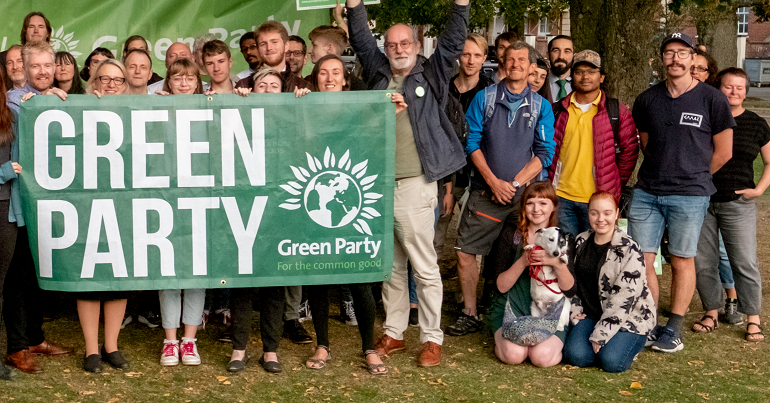Robert Reich
July 3, 2025

Trump’s 940-page Big Ugly Bill was passed today by the House and is now on the way to the White House for Trump’s signature.
It is a disgrace. It takes more than $1 trillion out of Medicaid — leaving about 12 million Americans without insurance by 2034 — and slashes Food Stamps, all to give a giant tax cut to wealthy Americans.
It establishes an anti-immigrant police state in America, replete with a standing army of ICE agents and a gulag of detention facilities that will transform ICE into the most heavily funded law enforcement agency in the government.
It will increase the already-bloated deficit by $3.4 trillion.
It’s also disgraceful because of how it came to be.
Trump was elected with only a plurality of American voters, not a majority. He eked out his win by a margin of only 1.5 percent.
His Big Ugly Bill squeaked by in the Senate by one vote, supplied by JD Vance, and by just two votes in the House. No Democrat in either chamber voted for it.
Polls show most Americans oppose it.
It was passed nevertheless — within an artificial deadline set by Trump — because of Trump’s total grip on the Republican Party.
Republican lawmakers feared that Trump would go after defectors with public attacks or endorsements of primary challengers.
They also feared withering blowback from conservative media, “MAGA” diehards, and Trump himself on social media.
After North Carolina Senator Thom Tillis announced his opposition to the bill, Trump posted on Truth Social, “Tillis is a talker and complainer, NOT A DOER! He’s even worse than Rand ‘Fauci’ Paul!”
Then Trump pledged to back a primary challenger to Tillis, and Tillis announced he would not seek re-election. Trump called that “good news,” and threatened primary challenges against other Republican fiscal conservatives standing in the way of the bill’s passage.
Other presidents in my lifetime have been able to summon majorities of lawmakers for unpopular causes — I think of Lyndon Johnson and the Civil Rights Act of 1964 and the Voting Rights Act of 1965 — but none with the retributive threats, social media fury, and potentially violent base of supporters that Trump is now wielding.
Needless to say, the Civil Rights and Voting Rights Acts made America more inclusive. Trump’s Big Ugly Bill makes America crueler.
The best analogy isn’t to Johnson. It’s to the “strongmen” of the 1930s — Hitler, Stalin, Mussolini, and Franco.
That such a regressive, dangerous, gargantuan, and unpopular piece of legislation could get through Congress shows how far Trump has dragged America into modern fascism.
Why presidential power should worry every American.

Protestors march during an anti-Trump "No Kings Day" demonstration in a city that has been the focus of protests against President Donald Trump's immigration raids on June 14, 2025 in downtown Los Angeles, California.
(Photo: Jay L Clendenin/Getty Images)
Corey Saylor
Jul 04, 2025
The Fourth of July marks the day America declared our independence from the idea that one man should hold unchecked power over an entire people and from a system that placed loyalty to the crown above fairness, above freedom, and above the law. That's the kind of government America's founding fathers risked their lives to overthrow.
Alexander Hamilton summed it up in Federalist No. 47, which most readers were required to read in high school, "The accumulation of all powers, legislative, executive, and judiciary, in the same hands, whether of one, a few, or many, and whether hereditary, self-appointed, or elective, may justly be pronounced the very definition of tyranny." President Donald Trump does not wear a crown, but some of his unilateral, unconstitutional actions—past and planned—echo the exact abuses that America's founders opposed. And whether you support him or not, this should give you pause.
I say this as someone not looking to insult or belittle anyone's vote. Millions of Americans supported Trump in 2024 for valid reasons. Many voters simply felt he was the better of two flawed choices. But if you're one of those Americans—someone who voted for Trump but doesn't want to see one man hold all the power—this message is for you.
A system that allows one person to "do whatever I want" is only comforting if you always agree with that person.
The Founders didn't just oppose King George III because of taxes or trade. They rejected the very idea that one man should rule without real accountability. The Declaration of Independence laid out a vision of a republic in which power is limited, divided, and checked.
Our system was built with friction on purpose—three co-equal branches, independent agencies, freedom of the press, and state sovereignty—all to prevent the rise of a single ruler.
Donald Trump has stated that Article II of the Constitution gives him "the right to do whatever I want as president."
Maybe you trust Trump with that power. Maybe you think he is using it wisely, or at least in your interests by abducting college students off of city streets because of their speech, cutting off federal funds to universities that refuse to cede academic freedom to the government, summarily stripping away birthright citizenship from children born in our nation, starting a war with another nation without any justification or congressional authorization, and funding a genocide in clear violation of U.S law. But what about the next president who runs with this precedent and goes even further? Or the one after that? A system that allows one person to "do whatever I want" is only comforting if you always agree with that person.
Many Americans, especially Republicans, have historically been skeptical of big government and concentrated power—and rightly so. Because when power gets centralized, it never stays in the hands of just one party.
Presidents of both parties have tested boundaries. But what President Trump proposes goes further: He's not testing the guardrails—he's removing them. And he's doing it while promising "retribution" and calling political opponents "enemies of the state."
The Declaration of Independence includes 27 grievances against King George III. Among them: obstructing justice, making judges dependent on his will alone, keeping standing armies under his personal command, manipulating elections, and using public offices as instruments of personal loyalty.
Read those carefully and reflect on the last few months.
As a Muslim, I'm also reminded that the warning against absolute authority isn't just a constitutional principle—it's a moral one. In Islam, power is a trust (amanah), not a privilege, and leaders are servants accountable to those they lead—and to God. Yusuf ben Ali, whose name appears in a revolutionary war era military muster role, is just one example of Muslims risking all for American ideals.
The Prophet Muhammad (peace be upon him) said, "Every one of you is a shepherd, and every one of you is responsible for his flock." American Muslims know what it's like when government power turns its gaze on a single community—through surveillance, profiling, and fear-mongering. That's why we are especially sensitive to executive overreach. Because when power becomes personal, the Constitution becomes optional.
Too often, we treat criticism of a president as disloyalty. But that's not how the Founders saw it. They built a system where debate, dissent, and accountability were patriotic. Where allegiance is owed to the Constitution—not to a man.
We can and should insist on a system where no one—left or right—can ignore the law, silence opponents, or rig the system for personal gain.
The Founders gave us a framework strong enough to withstand kings, tyrants, and demagogues—but only if we choose to uphold it. We uphold it by not letting any president—Trump, Joe Biden, or the next one—rule without limits. And that's something every American—no matter who you voted for—should stand up and defend.
Our work is licensed under Creative Commons (CC BY-NC-ND 3.0). Feel free to republish and share widely.
Corey Saylor is the research and advocacy director for the Council on American-Islamic Relations (CAIR), the nation’s largest Muslim civil rights and advocacy organization.
Full Bio >
Whenever any fascist regime of government becomes destructive to the future of humanity and the planet, it is the Responsibility of the People to drive it from power through nonviolent protest day after day.

Protesters carry a banner representing the Preamble to the U.S. Constitution in downtown Los Angeles during an anti-Trump "No Kings Day" demonstration in a city that has been the focus of protests against Trump's immigration raids on June 14, 2025 in Los Angeles, California.
(Photo: Mario Tama/Getty Images)
Paul Street
Jul 04, 2025
In Washington D.C., On This July 4th, 2025
IN THE NAME OF HUMANITY,
WE DECLARE OUR INDEPENDENCE FROM TRUMP’S FASCIST AMERICA
Whenever any fascist regime of government becomes destructive to the future of humanity and the planet, it is the Responsibility of the People to drive it from power through nonviolent protest day after day until the regime is removed from power.
Donald Trump must go NOW because he and his regime are fascist. Fascism is a radically reactionary qualitative change in how society is governed. Fascism foments and relies on xenophobic nationalism, virulent racism, misogyny, and the aggressive re-institution of oppressive “traditional values.” Fascist mobs and threats of violence are unleashed to build the movement and consolidate power. What is crucial to understand is that once in power fascism essentially eliminates traditional democratic rights.
The history of the Trump fascist regime is a history of repeated injuries, usurpations, and violence in the service of consolidating a fascist tyranny—assaulting truth, rule of law, the separation of powers and of church and state—while accelerating the climate catastrophe, endangering public health, and raising the risks of global war.
Let the facts be submitted.
To establish the rule of virulent white supremacy:
Trump has: re-exalted the slaveowners’ Confederacy; renamed U.S. military bases after Confederate “war heroes”; purged Black generals and racial diversity programs from the military; appointed white supremacists to key positions; racially whitewashed government websites and offices; made comments animalizing Black Haitian immigrants; removed Dr. Martin Luther King’ Jr.’s bust from the Oval Office; suggested that the nation’s first Black president face a “military tribunal”; assaulted the teaching and study of Black and Native American history; granted refugee status to white South African heirs of racist apartheid on the false claim that they are victims of “white genocide”; repeatedly spewed racist lies about people of color being unskilled and unqualified; and created a Supreme Court that ended anti-racist affirmative action in college admissions.
To cement the subjugation of women and erasure of LGBT people:
Trump has: bragged about being “the guy who ended” women’s fundamental right to abortion after his Supreme Court appointees reimposed the female enslavement of forced motherhood; repealed a government rule that requires medical providers to perform abortions required to save a pregnant woman’s life; threatened to use the archaic, 150-year-old Comstock Act to ban abortion in every state, with no exceptions; banned transgender care for minors; banned use of gender identity pronouns; stated that the gender identity on passports must match gender identity on birth certificates; and removed transgender service members from the military, making the false and dangerous claim that transgender troops cannot meet the military’s “high standards.”
To demonize whole peoples and threaten the world with “America First” xenophobia and imperialist aggression:
Trump has: unleashed militarized gendarmes to terrorize predominantly Latino immigrants with mass racially profiled kidnapping operations reminiscent of 1850s Fugitive Slave hunts from coast to coast; opened churches, schools, and immigration courts to his ferocious pursuit of brown-skinned immigrant bodies; attacked by executive fiat the core constitutional right of birthright citizenship, rendering stateless the children of undocumented immigrants born in this country; disappeared immigrants to torture prisons in El Salvador, with a green light from the Supreme Court to “deport” migrants to any third country or distant concentration camp; ordered the single largest de-legalization of human beings in U.S. history, stripping half a million Haitians, Cubans, and Venezuelans of their protected status overnight; illegally bombed Iran while threatening more “tragedy” to come; vowed to seize Greenland, threatened to annex Canada, deepened U.S. support for genocide in Gaza; and invoked “Manifest Destiny”, the 19th-century notion that America is divinely ordained to control all of North America.
And to establish a blatant dictatorship in which there is no rule of law and Trump is the law; where there is no due process, rights for the people, or recourse to redress the injustices of the regime; and political enemies are arrested, threatened, and suppressed:
Trump has: claimed that his reelection and second horrific administration are “God’s will” and refused to say whether he must honor the U.S. Constitution; waged a relentless war on truth, feeding his hate-filled base with one wild fascist lie after another; issued a barrage of illegal and unconstitutional executive orders; commanded the National Guard and the U.S. Marines to repress public protests of his mass deportation raids in Los Angeles, and threatened to arrest the governor of California and mayor of Los Angeles for voicing their opposition; made the Department of Justice a tool of retribution against his political enemies; blackmailed, bullied, and attacked the independence and integrity of leading law firms, universities, media corporations, and nonprofit organizations; defied federal court rulings; smeared and called for the impeachment of judges who rule against him; purged the military of leaders who might oppose his fascist moves; violated international law and the War Powers Act; and staged a military parade to announce the birth of a 21st-century fascist army loyal not to the rule of law, but to Trump personally.
A harsh historical truth made evident at great human cost in the previous century is that it is devastatingly difficult to dislodge fascists from power once they consolidate rule over state and society, as in Nazi Germany in the 1930s and in Chile under Pinochet in the 1970s. If they are not separated from authority prior to the cementing of their reign, it can become too late.
No matter how they attain power, fascist rule is never legitimate. The responsibility to expel fascists from power is particularly urgent when fascism threatens to consolidate control atop history’s most powerful nation in a time of deepening global climate catastrophe and a world full of ever more lethal nuclear weapons.
Refuse Fascism, appealing to all who care about justice and decency, declares: IN THE NAME OF HUMANITY, WE REFUSE TO ACCEPT A FASCIST AMERICA. TRUMP MUST GO NOW!
Please join Refuse Fascism in declaring and demonstrating independence from Trump’s Fascist America during four days of action in Washington D.C. July 1-4, 2025—details here: https://refusefascism.org/2025/06/25/come-to-d-c-july-1-4-four-days-of-historic-struggle/.











